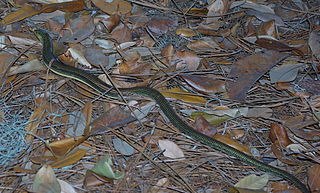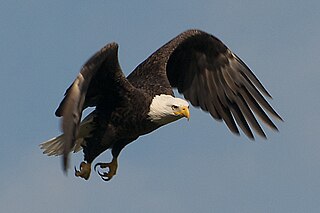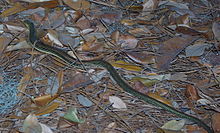
Amphisbaenia is a group of typically legless lizards, comprising over 200 extant species. Amphisbaenians are characterized by their long bodies, the reduction or loss of the limbs, and rudimentary eyes. As many species have a pink body and scales arranged in rings, they have a superficial resemblance to earthworms. While the genus Bipes retains forelimbs, all other genera are limbless. Phylogenetic studies suggest that they are nested within Lacertoidea, closely related to the lizard family Lacertidae. Amphisbaenians are widely distributed, occurring in North America, Europe, Africa, South America, Western Asia and the Caribbean. Most species are less than 6 inches (15 cm) long.

The Lacertidae are the family of the wall lizards, true lizards, or sometimes simply lacertas, which are native to Afro-Eurasia. It is a diverse family with at about 360 species in 39 genera. They represent the dominant group of reptiles found in Europe.

Anguidae refers to a large and diverse family of lizards native to the Northern Hemisphere. Common characteristics of this group include a reduced supratemporal arch, striations on the medial faces of tooth crowns, osteoderms, and a lateral fold in the skin of most taxa. The group is divided into two living subfamilies, the legless Anguinae, which contains slow worms and glass lizards, among others, found across the Northern Hemisphere, and Gerrhonotinae, which contains the alligator lizards, native to North and Central America. The family Diploglossidae was also formerly included. The family contains about 87 species in 8 genera.

Xenosauridae is a family of anguimorph lizards whose only living representative is the genus Xenosaurus, which is native to Central America. Xenosauridae also includes the extinct genera Exostinus and Restes. Also known as knob-scaled lizards, they have rounded, bumpy scales and osteoderms. Most living species prefer humid, rocky habitats, although they are widespread within their native regions, with some inhabiting semi-arid scrub environments. They are carnivorous or insectivorous, and give birth to live young.

Slowworms are a small genus (Anguis) of snake-like legless lizards in the family Anguidae. The genus has several living species, including the common slowworm, the eastern slowworm, the Greek slowworm, the Peloponnese slowworm, and the Italian slowworm. There are also known fossil species.

Ophisaurus is a genus of superficially snake-like legless lizards in the subfamily Anguinae. Known as joint snakes, glass snakes, or glass lizards, they are so-named because their tails are easily broken; like many lizards, they have the ability to deter predation by dropping off part of the tail, which can break into several pieces, like glass. The tail remains mobile, distracting the predator, while the lizard becomes motionless, allowing eventual escape. This serious loss of body mass requires a considerable effort to replace, and can take years to do so. Despite this ability, the new tail is usually smaller than the original.

Pseudopus is a genus of anguid lizards that are native to Eurasia. One extant species remains, the sheltopusik, with four fossil species. They are the most robust members of subfamily Anguinae. The oldest fossils of the group date to the Early Miocene, but there are possible Oligocene records.

The slender glass lizard is a legless lizard in the glass lizard subfamily (Anguinae). The species is endemic to the United States. Two subspecies are recognized. The lizard was originally believed to be a subspecies of the eastern glass lizard. Their name comes from their easily broken tail which they can break off themselves without ever being touched. It is difficult to find a specimen with an undamaged tail. The lizard eats a variety of insects and small animals, including smaller lizards. Snakes and other animals are known to prey on the species. Humans have a part in destroying their environment and killing their food supply with insecticides. The lizard is considered to be a least-concern species according to the International Union for Conservation of Nature (IUCN), though it is vulnerable in Iowa and endangered in Wisconsin. It is important to note that the streamlined, legless species is often confused with snakes. Glass Lizards, however, differ from snakes as they possess a moveable eyelid, which is absent in snakes. Another way to distinguish glass lizards from snakes is the presence of an external ear opening, which are absent in snakes.

The sheltopusik, also commonly called Pallas's glass lizard, the European legless lizard, or the European glass lizard, is a species of large glass lizard found from Southern Europe to Central Asia.

Ailuridae is a family in the mammal order Carnivora. The family consists of the red panda and its extinct relatives.

A sea eagle or fish eagle is any of the birds of prey in the subfamily Haliaeetinae of the bird of prey family Accipitridae. Ten extant species exist, currently described with this label.

Dopasia gracilis, known commonly as the Asian glass lizard, the Burmese glass lizard, or the Indian glass snake, is a species of legless lizard in the family Anguidae. The species is endemic to Asia.

Legless lizard may refer to any of several groups of lizards that have independently lost limbs or reduced them to the point of being of no use in locomotion. It is the common name for the family Pygopodidae. These lizards are often distinguishable from snakes on the basis of one or more of the following characteristics: possessing eyelids, possessing external ear openings, lack of broad belly scales, notched rather than forked tongue, having two more-or-less-equal lungs, and/or having a very long tail.

Koelliker's glass lizard, also called commonly the Moroccan glass lizard, is a species of lizard in the family Anguidae. The species is native to western North Africa.

Diploglossidae is a family of anguimorph lizards native to the Americas, with most genera being endemic to Hispaniola. Most members of this family are known as galliwasps. They were formerly considered a subfamily of Anguidae, but genetic evidence has shown them to be less closely related to other members of Anguidae than Anniellidae is.

The mimic glass lizard is a species of lizard in the family Anguidae. The species is endemic to the Southeastern United States. The mimic glass lizard is dark brown to black with a dark middorsal stripe down the body and on most of the tail. They have 3-4 dark stripes separated by pale stripes above the lateral grooves. They have a very distinct anatomy of the axis specifically when it comes to their second vertebra which could be attributed to an ecological adaptation, feeding, and/or defensive behavior that requires high head and neck mobility.

The Diplodactylidae are a family in the suborder Gekkota (geckos), with over 150 species in 25 genera. These geckos occur in Australia, New Zealand, and New Caledonia. Diplodactylids are the most ecologically diverse and widespread family of geckos in both Australia and New Caledonia, and are the only family of geckos found in New Zealand. Three diplodactylid genera have recently been split into multiple new genera.

Glyptosaurinae is an extinct subfamily of anguid lizards that lived in the Northern Hemisphere during the Late Cretaceous and the Paleogene.
















